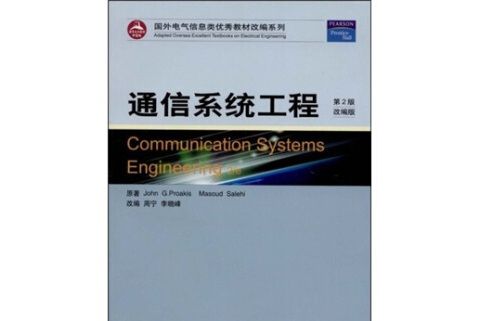《通信系統工程(第2版改編版)》是由普羅基斯、塞爾希主編,高等教育出版社2005年出版的中等職業教育德育課課程改革國家規劃新教材配套教學用書。
基本介紹
- 中文名:通信系統工程(第2版)(改編版)
- 作者:普羅基斯、塞爾希
- 出版社:高等教育出版社
- 出版時間:2006年3月1日
- 頁數:801 頁
- 裝幀:平裝
- ISBN:9787040169058
教材內容,教材目錄,
教材內容
《通信系統工程(第2版改編版)》內容:The objective of this book is to provide an introduction to the basic princi ples in the analysis and design of communication systems. It is primarily intended for use as a text for a first course in communications, either at a senior level or at a firstyear graduate level.BROAD TOPICAL COVERAGE Although we have placed a very strong emphasis on digital communications, we have provided a solid introduction to analog communications. The major topics covered are: An introduction to analog signal transmission and reception (Chapters 2and3)An introduction to digital communications (Chapters 48)EMPHASIS ON DIGITAL COMMUNICATIONS Our motivation for emphasizing digital communications is due to the techno logical developments that have occurred during the past five decades. To day, digital communication systems are in common use and generally carry the bulk of our daily information transmission through a variety of communi cations media, such as wireline telephone channels, microwave radio, fiber optic channels, and satellite channels.
教材目錄
PREFACE
1 INTRODUCTION
1. 1 Historical Review 1
1.2 Elements of an Electrical Communication System
1.2.1 Digital Communication System 9
1.2.2 Early Work in Digital Communications 13
1.3 Communication Channels and Their Characteristics
1.4 Mathematical Models for Communication Channels
1.5 Organization of the Book 28
1.6 Further Reading 30
2 ANALOG SIGNAL TRANSMISSION AND RECEPTION
2.1 Introduction to Modulation 32
2.2 Amplitude Modulation (AM) 33
2.2.1 Double-Sideband Suppressed Carrier AM 33
2. 2. 2 Conventional Amplitude Modulation 40
2.2.3 Single-Sideband AM 44
* 2.2.4 Vestigial-Sideband AM 48
2.2.5 Implementation of AM Modulators and Demodulators 52
2.2.6 Signal Multiplexing 58
2.3 Angle Modulation 61
2.3. 1 Representation of FM and PM Signals 62
2.3.2 Spectral Characteristics of Angle-Modulated Signals 66
2.3. 3 Implementation of Angle Modulators and Demodulators 73
2.4 Radio and Television Broadcasting 81
2.4.1 AM Radio Broadcasting 82
2.4. 2 FM Radio Broadcasting 84
2.4.3 Television Broadcasting 87
2.5 Mobile Radio Systems 97
2.6 Further Reading 100
Problems 100
3 EFFECT OF NOISE ON ANALOG COMMUNICATION SYSTEMS 115
3.1 Effect of Noise on Linear-Modulation Systems 115
3.1.1 Effect of Noise on a Baseband System 116
3. 1.2 Effect of Noise on DSB-SC AM 116
3. 1.3 Effect of Noise on SSB AM 118
3.1.4 Effect of Noise on Conventional AM 119
*3.2 Carrier-Phase Estimation with a Phase-Locked Loop (PLL) 124
3.2. 1 The Phase-Locked Loop ( PLL ) 125
3.2.2 Effect of Additive Noise on Phase Estimation 128
3.3 Effect of Noise on Angle Modulation 135
3.3. 1 Threshold Effect in Angle Modulation 145
3.3.2 Pre-emphasis and De-emphasis Filtering 149
3.4 Comparison of Analog-Modulation Systems 153
3.5 Further Reading 154
Problems 155
4 INFORMATION SOURCES AND SOURCE CODING 161
4.1 Modeling of Information Sources 162
4. 1.1 Measure of Information 164
4.1.2 Joint and Conditional Entropy 167
4.2 Source-Coding Theorem 169
4.3 Source-Coding Algorithms 172
4.4 Rate-Distortion Theory 177
4. 4. 1 Mutual Information 178
4. 4. 2 Differential Entropy 179
4.4.3 Rate-Distortion Function 181
4.5 Quantization 187
4.5. 1 Scalar Quantization 188
* 4.5.2 Vector Quantization 198
4.6 Waveform Coding 201
4.6. 1 Pulse-Code Modulation ( PCM) 201
4. 6. 2 Differential Pulse-Code Modulation ( DPCM) 207
4.6. 3 Delta Modulation (AM) 210
4.7 Digital Audio Transmission and Digital Audio Recording 213
4. 7. 1 Digital Audio in Telephone Transmission Systems 214
* 4. 7. 2 Digital Audio Recording 216
4.8 Further Reading 221
Problems 222
5 DIGITAL TRANSMISSION THROUGH THE ADDITIVE WHITE GAUSSIAN NOISE CHANNEL
6 DIGITAL TRANSMISSION THROUGH BANDLIMITED AWGN CHANNELS
7 CHANNEL CAPACITY AND CODING
8 WIRELESS COMMUNICATIONS
REFERENCES
INDES

